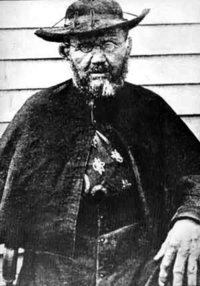Leprosy
Leprosy, sometimes known as Hansen's disease, is an infectious disease caused by Mycobacterium leprae, an aerobic, acid fast, rod-shaped mycobacterium. The modern term for the disease is named after the discoverer of the bacterium, Gerhard Armauer Hansen. more...
Sufferers of Hansen's disease have historically been known as lepers, however this term is falling into disuse as a result of the diminishing number of leprosy patients and the pejorative connotations of the term. In fact the term now that is most widely accepted among people and agencies working in the field of leprosy is 'people affected by leprosy'. The terms "leprosy" and "lepers" can also lead to public misunderstanding because the Bible uses these terms in reference to a wide range of skin conditions other than Hansen's disease.
Historically, leprosy was an incurable and disfiguring disease. Lepers were shunned and sequestered in leper colonies. Today, leprosy is easily curable by multidrug antibiotic therapy. The main challenges in the eradication of Hansen's disease is in reaching populations that have not yet received multidrug therapy services, improving detection of the disease, and providing patients with high-quality services and affordable drugs.
Other than humans, the only animals known to be susceptible to leprosy are the armadillo, mangabe monkeys, rabbits, and mice (on their footpads).
History
Hansen's disease has been recognized as a problem since the beginning of recorded history. It has been reported as early as 1350 BC in Egypt. "The oldest recorded disease" or "the oldest known disease" is a title given to this disease , as well as arthritis , gout , anthrax , schistosomiasis , and many other diseases. Lepers have frequently lived on the edge of society, and the disease was believed for a long time to have been caused by a divine (or demonic) curse or punishment. However, in the Middle Ages it was believed that lepers are cursed by humans, but loved by God.
During the Middle Ages, it was believed that leprosy was highly contagious and could be spread by the glance of a leper or an unseen leper standing upwind of healthy people. Nowadays, it is known that leprosy is only weakly contagious.
Minorities like the Navarrese agotes or French cagots were accused of being lepers.
Clinical features
The disease is caused by a mycobacterium which multiplies very slowly and mainly affects the skin, nerves, and mucous membranes. The organism has never been grown in bacteriologic media or cell culture, but has been grown in mouse foot pads and more recently in nine-banded armadillos. It is related to M. tuberculosis, the mycobacterium that causes tuberculosis. The difficulty in culturing the organism appears to be due to the fact that the organism is an obligate intra-cellular parasite that lacks many necessary genes for independent survival. The complex and unique cell wall that makes mycobacterium family difficult to destroy is apparently also the reason for the extremely slow replication rate.
Read more at Wikipedia.org



